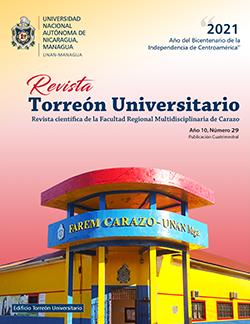Degradación microbiana de residuos de plaguicidas en dispositivos de biorremediación de tipo cama biológica
DOI:
https://doi.org/10.5377/rtu.v10i29.12741Palabras clave:
Sustrato biológico, cipermetrina, degradación, contaminación puntual, hongos ligninolíticosResumen
El manejo inadecuado de residuos de agroquímicos en sitios de producción agrícola implica un riesgo potencial de contaminación de las aguas superficiales y subterráneas. En estos lugares existen fuentes puntuales de contaminación que, por lixiviación o escorrentía depositan contaminantes en los cuerpos de agua aledaños a las zonas de cultivo. Para reducir este riesgo en algunas zonas se utilizan camas biológicas, esta es una matriz biológicamente activa que retiene y acelera la degradación de plaguicidas por medio de hongos ligninolíticos que se desarrollan en el material lignocelulósico que compone la cama biológica.
En este estudio se evaluó la capacidad de dos sustratos biológicos para degradar y retener cipermetrina, uno elaborado con paja de sorgo y otro utilizando cascara de coco como material lignocelulósico, los experimentos realizados reflejan que el sustrato elaborado a base de paja de sorgo tiene una mayor eficiencia en cuanto a retención y degradación de cipermetrina logrando retener en promedio del 37 % de la mezcla agregada y se estimó una degradación del 90 % de la cipermetrina en un periodo de treinta días.
Descargas
944
HTML 261
VISOR 0
PDF (English) 186
HTML (English) 68
Citas
Aislabie, J., & Lloyd-Jones, G. (1955). A review of bacterial degradation of pesticides. Australian journal of soil research, 925-942.
Aparicio, V., De Gerónimo, E., Hernández, K., Pérez, D., Portocarrero, R., & Vidal, C. (2015). Los plaguicidas agregados al suelo y su destino en el ambiente. INTA.
Castillo, M., Torstensson, L., & Stenström, J. (2008). Camas Biológicas Para La Preservación Del Medio Ambiente De La Contaminación Por Pesticidas. Journal of Agricultural and Food Chemistry 56, 6206-6219.
Meleiro, A., Zelayrán, G., Consiglio, M., & Nitschke, M. (2011). Biodegradation of Pesticides. Pesticides in the Modern World – Pesticides Use and Management, 407-438
Mendoza, J., Perea, Y., Salvador, J., Morales, J., & Pérez, G. (2011). Biodegradación bacteriana de plaguicidas permetrina y cipermetrina en cultivo lote. Avances en ciencia e ingeniería, 45-55.
Prinsen, P. (2013). Caracterización química y estructural de lignina y lípidos de materiales lignocelulósicos de interés industrial (Memoria de investigación para optar al grado de doctor en ciencias químicas). Sevilla, España.
Proyecto D09R1006. (2013). Manual de construcción y operación de lechos biológicos. Universidad de La Frontera.
Rodríguez, C., Castro, V., & Lizano, V. (2018). Alternative approaches to determine the efficiency of biomixtures used for pesticide degradation in biopurification systems. En E. Dino, & R. Nallin, Toxicity and biodegradation testing (págs. 57-73)
World Health Organization. (1989). Environmental Health Criteria. Cypermethrin. Ginebra.
Xie, W.-J., Zhou, J.-M., Wang, H.-Y., & Chen, X.-Q. (2008). Effect of nitrogen on the degradation of cypermethrin and its metabolite 3-phenoxybenzoic acid in soil. Pedosphere, 638–644.
Descargas
Publicado
Cómo citar
Número
Sección
Licencia
Derechos de autor 2021 Universidad Nacional Autónoma de Nicaragua, Managua

Esta obra está bajo una licencia internacional Creative Commons Atribución-NoComercial-SinDerivadas 4.0.
Los autores que publican en esta revista están de acuerdo con los siguientes términos.
- El autor o los autores de los artículos, ensayos o investigaciones conceden a la Universidad Nacional Autónoma de Nicaragua, Managua (UNAN-Managua) los derechos de edición (copyright) del trabajo enviado, por consiguiente la Universidad cuenta con el derecho exclusivo para publicar el artículo durante el periodo completo de los derechos de autor.
- Estos derechos de autor/ autores autorizan a la Revista Torreón Universitario y a la Universidad editar y divulgar/publicar el artículo en dicha Revista, incluyendo reproducción impresa y electrónica, el almacenamiento, recuperación y cualquier otro tipo de publicación, y fuentes de información secundaria como servicios de resúmenes y bases de datos, así mismo la facultan a proteger el artículo contra el uso no autorizado para su difusión por medios impresos o electrónicos (PDF, HTML, EPUB, XML u otros).
Licencia para el uso del contenido
La revista hace uso de la Licencia Creative Commons Atribución-NoComercial-SinDerivar 4.0 Internacional.
Bajo esta declaración:

Este revista está sujeta a una licencia de Creative Commons Reconocimiento-NoComercial-SinObraDerivada 4.0 Internacional. Puede ser copiada, distribuida y transmitida públicamente siempre y cuando se cite al autor y la fuente (Revista Torreón Universitario), no debe modificarse ni utilizarse con ningún fin comercial. La licencia completa se puede consultar en http://creativecommons.org/licenses/by-nc-nd/4.0/.



